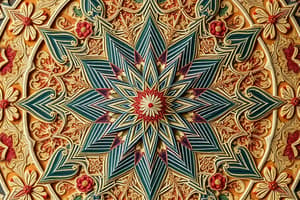Podcast
Questions and Answers
What is the significance of patterns in nature according to the discussion?
What is the significance of patterns in nature according to the discussion?
- They help us predict future occurrences. (correct)
- They are irrelevant to mathematical concepts.
- They serve only aesthetic purposes.
- They only exist in man-made environments.
Which type of pattern involves discovering meaningful patterns in unpredictable situations?
Which type of pattern involves discovering meaningful patterns in unpredictable situations?
- Geometric pattern
- Word pattern
- Logic pattern (correct)
- Number pattern
What characteristic defines a number pattern?
What characteristic defines a number pattern?
- It follows a definite rule. (correct)
- It is a random sequence of numbers.
- It is formed without any rules.
- It is only based on geometric shapes.
What type of pattern is NOT mentioned as one of the four types in the lesson?
What type of pattern is NOT mentioned as one of the four types in the lesson?
What can the honeybee’s construction of the honeycomb demonstrate?
What can the honeybee’s construction of the honeycomb demonstrate?
Which of the following best describes 'logic patterns'?
Which of the following best describes 'logic patterns'?
Why is understanding patterns important in mathematics?
Why is understanding patterns important in mathematics?
Which of the following is NOT a type of pattern discussed in the lesson?
Which of the following is NOT a type of pattern discussed in the lesson?
What kind of symmetry is predominantly found in animals and some leaves?
What kind of symmetry is predominantly found in animals and some leaves?
What mathematical concept describes patterns formed by repeated self-similarity?
What mathematical concept describes patterns formed by repeated self-similarity?
How does a leopard's spotted pattern benefit its survival?
How does a leopard's spotted pattern benefit its survival?
Which pattern is characterized by shapes that are arranged in a repeated manner, like polygons?
Which pattern is characterized by shapes that are arranged in a repeated manner, like polygons?
What type of pattern involves the growth of shells in an organism like the nautilus?
What type of pattern involves the growth of shells in an organism like the nautilus?
Which statement best describes the concept of waves?
Which statement best describes the concept of waves?
What is not a characteristic of fractals?
What is not a characteristic of fractals?
Which of the following describes a pattern formed by jumbled words?
Which of the following describes a pattern formed by jumbled words?
Flashcards are hidden until you start studying
Study Notes
Patterns in Nature
- Patterns appear in various forms, such as flower petals and leaf arrangements, showcasing nature's diversity.
- Common natural patterns include colors and shapes, evidenced by phenomena like rainbows or butterfly wings.
- Patterns help us comprehend the environment, leading to questions about their formation and underlying rules.
Types of Patterns
- Logic Patterns: Ability to detect meaningful patterns in unfamiliar situations, influencing thought and behavior.
- Number Patterns: A sequence formed by a specific rule, such as odd numbers (1, 3, 5, 7...) where each term is derived by adding 2 to the previous one.
- Geometric Patterns: Represented by geometric shapes, showcasing order and structure in space.
- Word Patterns: Involve jumbled words that require logic to decipher meaning.
Importance of Patterns
- Patterns aid in predicting future occurrences and understanding past events.
- They manifest in daily life through shapes, colors, numbers, and repetitions.
Symmetry
- Symmetry is common in the natural world, particularly in animals and plants.
- Bilateral symmetry is seen in many animals and certain plant leaves, while radial symmetry is common in flowers and some animals.
Trees and Fractals
- The branching structure of trees reflects a proportional relationship to the thickness of the trunk.
- Fractals illustrate self-similarity, created through mathematical iterations, though only approximate in nature.
Spirals
- Spiral patterns are frequently observed in flora and fauna, like the nautilus shell, which features logarithmic spirals and self-similar characteristics.
Spots and Stripes
- Animal patterns, such as spots and stripes, serve evolutionary purposes including camouflage, which enhances survival chances.
Waves and Dunes
- Waves propagate energy through mediums like air or water, causing oscillation, while dunes represent patterns formed by wind or water movements.
Studying That Suits You
Use AI to generate personalized quizzes and flashcards to suit your learning preferences.




